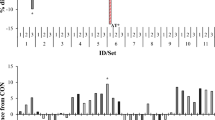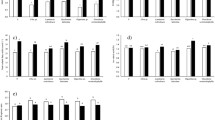Abstract
This study aimed to identify the optimal doses of the macroalgae Asparagopsis taxiformis and Oedogonium sp., individually and in combination, which would decrease the in vitro production of methane while minimizing adverse effects on fermentation, using rumen inoculant from Bos indicus steers. The dose-response experiment evaluated ten doses of Asparagopsis [ranging from 0 to 16.7 % of the organic matter (OM) incubated] and seven doses of Oedogonium (ranging from 0 to 100 % OM) using Rhodes grass hay as a basal substrate. Asparagopsis was highly effective in decreasing the production of methane with a reduction of 99 % at doses as low as 2 % OM basis. However, a dose of 2 % OM also decreased the production of volatile fatty acids (VFA). Oedogonium was less effective with doses ≥50 % OM significantly decreasing the production of methane. A combination of Asparagopsis (2 % OM) and Oedogonium (25 and 50 % OM) continued to suppress the production of methane, independent of the inclusion rate of Oedogonium. The effectiveness of Asparagopsis demonstrates its potential for the mitigation of methane emissions from ruminants at inclusion rates of ≤2 % OM. Oedogonium is a potential feed supplement due to its nutritional value, but supplements ≤25 % OM are recommended to avoid adverse effects on apparent in vitro fermentation.




Similar content being viewed by others
References
Anderson M, Gorley R, Clarke K (2008) Permanova + for primer: guide to software and statistical methods. Primer-E, Plymouth
Beauchemin K, McGinn S (2006) Methane emissions from beef cattle: effects of fumaric acid, essential oil, and canola oil. J Anim Sci 84:1489–1496
Beauchemin KA, McGinn SM, Petit HV (2007) Methane abatement strategies for cattle: lipid supplementation of diets. Can J Anim Sci 87:431–440
Bodas R, Prieto N, García-González R, Andrés S, Giráldez FJ, López S (2012) Manipulation of rumen fermentation and methane production with plant secondary metabolites. Anim Feed Sci Technol 176:78–93
Chen R, Li R, Deitz L, Liu Y, Stevenson RJ, Liao W (2012) Freshwater algal cultivation with animal waste for nutrient removal and biomass production. Biomass Bioenergy 39:128–138
Cieslak A, Szumacher-Strabel M, Stochmal A, Oleszek W (2013) Plant components with specific activities against rumen methanogens. Animal 7:253–265
Cieslak A, Zmora P, Stochmal A, Pecio L, Oleszek W, Pers-Kamczyc E, Szczechowiak J, Nowak A, Szumacher-Strabel M (2014) Rumen antimethanogenic effect of Saponaria officinalis L. phytochemicals in vitro. J Agri Sci 152:981–993
Clarke KR, Gorley RN (2006) Primer v6: user manual/tutorial. Primer-E Ltd, Plymouth
Cole AJ, de Nys R, Paul NA (2015) Biorecovery of nutrient waste as protein in freshwater macroalgae. Algal Res 7:58–65
Cone JW, van Gelder AH (1999) Influence of protein fermentation on gas production profiles. Anim Feed Sci Technol 76:251–264
Dubois B, Tomkins NW, Kinley RD, Bai M, Seymour S, Paul NA, de Nys R (2013) Effect of tropical algae as additives on rumen in vitro gas production and fermentation characteristics. Am J Plant Sci 4:34–43
France J, Dijkstra J (2005) Volatile fatty acid production. In: Forbers J, France J (eds) Quantitative aspects of ruminant digestion and metabolism. CAB International, Oxon, pp 157–175
Goel G, Makkar HPS (2012) Methane mitigation from ruminants using tannins and saponins. Trop Anim Health Prod 44:729–739
Goel G, Makkar HP, Becker K (2009) Inhibition of methanogens by bromochloromethane: effects on microbial communities and rumen fermentation using batch and continuous fermentations. Br J Nutr 101:1484–1492
Goering H, Van Soest PJ (1970) Forage fiber analyses (apparatus, reagents, procedures, and some applications), vol 379. US Agricultural Research Service, Washington
Hristov A, Oh J, Firkins J, Dijkstra J, Kebreab E, Waghorn G, Makkar H, Adesogan A, Yang W, Lee C (2013) Special topics—Mitigation of methane and nitrous oxide emissions from animal operations: I. A review of enteric methane mitigation options. J Anim Sci 91:5045–5069
Hu B, Zhou W, Min M, Du Z, Chen P, Ma X, Liu Y, Lei H, Shi J, Ruan R (2013) Development of an effective acidogenically digested swine manure-based algal system for improved wastewater treatment and biofuel and feed production. Appl Energy 107:255–263
Johnson KA, Johnson DE (1995) Methane emissions from cattle. J Anim Sci 73:2483–2492
Kinley R, Fredeen A (2014) In vitro evaluation of feeding North Atlantic stormtoss seaweeds on ruminal digestion. J Appl Phycol. doi:10.1007/s10811-014-0487-z
Lawton RJ, de Nys R, Paul NA (2013) Selecting reliable and robust freshwater macroalgae for biomass applications. PLoS ONE 8(5), e64168
Lee S, Yang S, Lee W, Kim H, Shin D, Ha JK (2009) Effect of 2-bromoethanesulfonic acid on in vitro fermentation characteristics and methanogen population. Asian-Australas J Anim Sci 22:42–48
Lourenço SO, Barbarino E, De-Paula JC, Pereira LOS, Marquez UML (2002) Amino acid composition, protein content and calculation of nitrogen‐to‐protein conversion factors for 19 tropical seaweeds. Phycol Res 50:233–241
Machado L, Kinley RD, Magnusson M, de Nys R, Tomkins NW (2014a) The potential of macroalgae for beef production systems in Northern Australia. J Appl Phycol. doi:10.1007/s10811-014-0439-7
Machado L, Magnusson M, Paul NA, de Nys R, Tomkins N (2014b) Effects of marine and freshwater macroalgae on in vitro total gas and methane production. PLoS ONE 9(1), e85289
Martínez-Fernández G, Abecia L, Martín-García A, Ramos-Morales E, Hervás G, Molina-Alcaide E, Yáñez-Ruiz D (2013) In vitro–in vivo study on the effects of plant compounds on rumen fermentation, microbial abundances and methane emissions in goats. Animal 7:1925–1934
Mateos I, Ranilla M, Tejido M, Saro C, Kamel C, Carro MD (2013) The influence of diet type (dairy versus intensive fattening) on the effectiveness of garlic oil and cinnamaldehyde to manipulate in vitro ruminal fermentation and methane production. Anim Prod Sci 53:299–307
Meale S, Chaves A, Baah J, McAllister T (2012) Methane production of different forages in in vitro ruminal fermentation. Asian-Australas J Anim Sci 25:81–91
NHMRC (National Health and Medical Research Council) (2004) Australian code of practice for the care and use of animals for scientific purposes. Canberra, Australia. http://www.nhmrc.gov.au/_files_nhmrc/publications/attachments/ea16_animal_code.pdf
Morgavi D, Forano E, Martin C, Newbold CJ (2010) Microbial ecosystem and methanogenesis in ruminants. Animal 4:1024–1036
Neveux N, Magnusson M, Maschmeyer T, de Nys R, Paul NA (2014) Comparing the potential production and value of high-energy liquid fuels and protein from marine and freshwater macroalgae. GCB Bioenergy. doi:10.1111/gcbb.12171
O'Brien M, Navarro-Villa A, Purcell P, Boland T, O'Kiely P (2014) Reducing in vitro rumen methanogenesis for two contrasting diets using a series of inclusion rates of different additives. Anim Prod Sci 54:141–157
Patra AK (2011) Effects of essential oils on rumen fermentation, microbial ecology and ruminant production. Asian J Anim Vet Adv 6:416–428
Patra AK (2012) Enteric methane mitigation technologies for ruminant livestock: a synthesis of current research and future directions. Environ Monit Assess 184:1929–1952
Paul N, de Nys R, Steinberg P (2006) Chemical defence against bacteria in the red alga Asparagopsis armata: linking structure with function. Mar Ecol Prog Ser 306:87–101
Poppi DP, McLennan SR (1995) Protein and energy-utilization by ruminants at pasture. J Anim Sci 73:278–290
Reay D, Smith P, van Amstel A (2010) Methane sources and the global methane budget. In: Reay D, Smith P, van Amstel A (eds) Methane and climate change. Earthscan Ltd., Washington, pp 1–13
Russell J, O'connor J, Fox D, Van Soest P, Sniffen C (1992) A net carbohydrate and protein system for evaluating cattle diets: I. Ruminal fermentation. J Anim Sci 70:3551–3561
Scollan N, Hocquette J-F, Nuernberg K, Dannenberger D, Richardson I, Moloney A (2006) Innovations in beef production systems that enhance the nutritional and health value of beef lipids and their relationship with meat quality. Meat Sci 74:17–33
Tomkins N, Colegate S, Hunter R (2009) A bromochloromethane formulation reduces enteric methanogenesis in cattle fed grain-based diets. Anim Prod Sci 49:1053–1058
Wang Y, Xu Z, Bach S, McAllister T (2008) Effects of phlorotannins from Ascophyllum nodosum (brown seaweed) on in vitro ruminal digestion of mixed forage or barley grain. Anim Feed Sci Technol 145:375–395
Wood J, Kennedy FS, Wolfe R (1968) Reaction of multihalogenated hydrocarbons with free and bound reduced vitamin B12. Biochemistry 7:1707–1713
Woolard FX, Moore RE, Roller PP (1979) Halogenated acetic and acrylic acids from the red alga Asparagopsis taxiformis. Phytochemistry 18:617–620
Zhou Z, Meng Q, Yu Z (2011) Effects of methanogenic inhibitors on methane production and abundances of methanogens and cellulolytic bacteria in in vitro ruminal cultures. Appl Environ Microbiol 77:2634–2639
Acknowledgments
This research is part of the MBD Energy Research and Development program for Biological Carbon Capture and Storage. This project is supported by funding from the Australian Government Department of Agriculture through the National Livestock Methane Production Project, the Australian Government through the Australian Renewable Energy Agency, and the Advanced Manufacturing Cooperative Research Centre (AMCRC), funded through the Australian Government’s Cooperative Research Centre Scheme. We thank Dr. Pedro de Paula Silva for assistance with the experiments and Dr. Matthew Vucko for the advice with the statistical analyses. We also thank Jeffrey Palpratt for handling and maintenance of the donor steers, and Dr. Shane Askew from the Advanced Analytical Centre, JCU, for analytical advice
Author information
Authors and Affiliations
Corresponding author
Electronic supplementary material
Below is the link to the electronic supplementary material.
Table S1
Results of full factorial permutational analyses of variance (PERMANOVAs) testing the effects of the fixed factors time (Ti), dose of Oedogonium (Do), and addition of Asparagopsis (Ad) on Gas parameters, VFA profiles, OMdeg, and pH of treatments in the macroalgae combination experiment. Analyses were conducted in Primer v6 (Primer-E Ltd, UK) using Bray-Curtis dissimilarities on fourth root transformed data and 999 unrestricted permutations of raw data. Pseudo F (F) and P values are presented, significant terms shown in bold. (DOCX 18 kb)
Rights and permissions
About this article
Cite this article
Machado, L., Magnusson, M., Paul, N.A. et al. Dose-response effects of Asparagopsis taxiformis and Oedogonium sp. on in vitro fermentation and methane production. J Appl Phycol 28, 1443–1452 (2016). https://doi.org/10.1007/s10811-015-0639-9
Received:
Revised:
Accepted:
Published:
Issue Date:
DOI: https://doi.org/10.1007/s10811-015-0639-9




